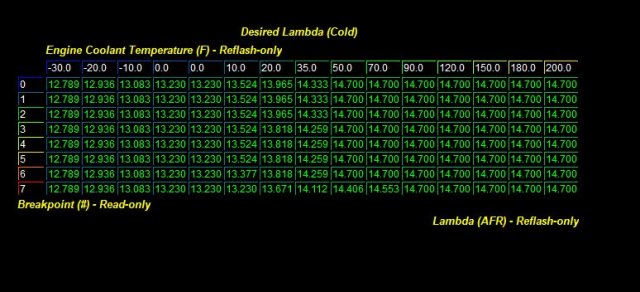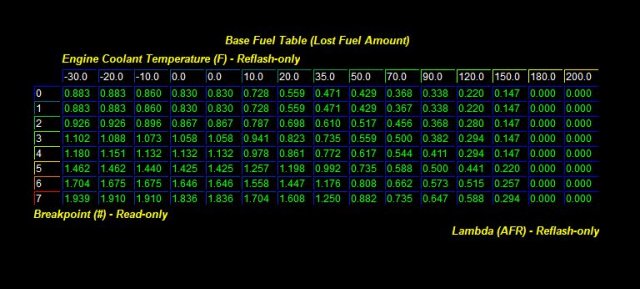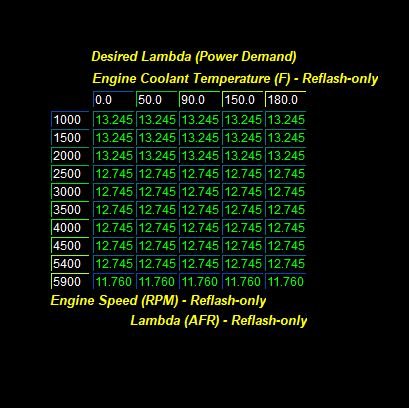So a little while ago I got a Stratified Stage 1 flash tune on 91oct (I live in Denver). I just have a K&N high flow filter and no other power mods. I've noticed that when cold starting the AFR is around 15.5 and moves around by a few tenths (up and down). Eventually it will get to 14.7 but takes a while (15min maybe) and maybe some driving to do so. I'm getting a refinement on the tune from them (just sent in my datalogs) and asked them about this and they said to do a smoke test to make sure there're no leaks. So, I have a couple questions. Is this normal? Anything I can do or check before getting the smoke test?
-
Sign Up! To view all forums and unlock additional cool features
Welcome to the #1 Fiesta ST Forum and Fiesta ST community dedicated to Fiesta ST owners and enthusiasts. Register for an account, it's free and it's easy, so don't hesitate to join the Fiesta ST Forum today!
AFR around 15.5 at idle
- Thread starter WhatUpImJustin
- Start date
ECU commands 15.5 or 15.7 (i forget which of the two it is) AFR at cold start to heat the engine up faster. Mine does the same thing. Totally normal
That would be incorrect. The cold AFR is 14.7 as is the hot AFR at idle. The rpms/ETC value will be different, but commanded AFR is always 14.7 until the Optimum Power threshold is breached or the Actual Load is increased.
Because commanded is 15.7 on cold start.
Last edited:
https://www.carthrottle.com/post/why-are-cold-starts-so-loud/?comments_page=2
Cool carthrottle article explaining why you might see leaner AFR on cold start due to unideal fuel vaporization when cold.
Disclaimer: Below is just a hypothesis, don’t take it for gospel.
My guess is Ford might technically command 15.7AFR but actually might be requesting more fuel for starting, with more fuel, Ford may want more air to get secondary combustion so unburnt fuel doesn’t clog the cat, this additional air may be seen by the upstream O2 sensor as lean mixture.
Cool carthrottle article explaining why you might see leaner AFR on cold start due to unideal fuel vaporization when cold.
Disclaimer: Below is just a hypothesis, don’t take it for gospel.
My guess is Ford might technically command 15.7AFR but actually might be requesting more fuel for starting, with more fuel, Ford may want more air to get secondary combustion so unburnt fuel doesn’t clog the cat, this additional air may be seen by the upstream O2 sensor as lean mixture.
Unless you have evidence showing otherwise, I’m going to take Jason’s word on it, but I’m open to new info.
Here is the actual table from the stock ECU map for cold engine running. Notice that the colder the ECT, the RICHER the targeted AFR.

Here is the table for "Lost Fuel" during cold start. This table shows the fuel added to compensate for the fuel not burned at initial cold start due to the fuel "sticking" to the cold surfaces such that it isn't burned right away. Again notice the ECU is ADDING more fuel with the colder ECTs, especially at higher Load.

I don't know Jason from Dick, but I do know how the ECU works and I tune my own vehicles using both Cobb and HPTuners software. The ECU is always targeting nothing leaner than 14.7 AFR.
Here is the actual table from the stock ECU map for cold engine running. Notice that the colder the ECT, the RICHER the targeted AFR.
View attachment 39606
Here is the table for "Lost Fuel" during cold start. This table shows the fuel added to compensate for the fuel not burned at initial cold start due to the fuel "sticking" to the cold surfaces such that it isn't burned right away. Again notice the ECU is ADDING more fuel with the colder ECTs, especially at higher Load.
View attachment 39607
Here is the actual table from the stock ECU map for cold engine running. Notice that the colder the ECT, the RICHER the targeted AFR.
View attachment 39606
Here is the table for "Lost Fuel" during cold start. This table shows the fuel added to compensate for the fuel not burned at initial cold start due to the fuel "sticking" to the cold surfaces such that it isn't burned right away. Again notice the ECU is ADDING more fuel with the colder ECTs, especially at higher Load.
View attachment 39607
Could these tables be altered by the tuner? I’m assuming the lean means some type of vacuum leak, but why would that go away once warm? And not leak under boost?
edit: also could you share a 101 on open vs closed loop
edit2: ate those tables for power threshold or for idle? I was under the impression that they were separate. In my case, the AFR goes right back to normal when I'm on the throttle at all
Last edited:
Thanks for sharing this. Jason is one of the more popular tuners for this platform and regularly participates in these forum discussions.
Could these tables be altered by the tuner? I’m assuming the lean means some type of vacuum leak, but why would that go away once warm? And not leak under boost?
edit: also could you share a 101 on open vs closed loop
Could these tables be altered by the tuner? I’m assuming the lean means some type of vacuum leak, but why would that go away once warm? And not leak under boost?
edit: also could you share a 101 on open vs closed loop
- If the AFR is actually 15.5 consistently, your fuel trims (Short Term and possibly Long Term depending on how long the AFR is that lean) should be positive showing the ECU adding fuel. Those values STFT and LTFT are important. Before a leak can be declared, the trims must be known. The trims become active shortly after a startup, so you need to monitor them during the whole drive cycle to determine any trends.
CLOSED/OPEN LOOP
Older Vehicle versions. There are additional nuances for the different systems, but these are the main points:
- CLOSED LOOP - On older vehicles the CLOSED LOOP function means the ECU is using a narrow-band O2 sensor as the feedback for the ECU to control the fueling so the AFR remains very near the stoic value of 14.7 for pure gasoline and 14.08 for the more common ~10% ethanol blends. The earliest desire for this control was/is for emissions control. The side benefit for enthusiasts is that the electronic fueling controls are significantly more precise and tunable than carburetors.
- OPEN LOOP - On older vehicles the OPEN LOOP function means the ECU has abandoned the narrow-band O2 sensor feedback and is fueling based on read-only tables with RPM and Airflow as the X/Y table inputs. Although the early closed loop systems were very good at low throttle/low rev fueling for idle and cruise, they couldn't keep up at big throttle/high revs, so the fixed tables were used for real power tuning.
- Many newer vehicles (especially the Ford Ecoboost) use CLOSED LOOP for ALL fueling functions where the ECU uses wide-band O2 sensor(s) to provide feedback to control the fueling such that the AFR is very precisely controlled under ALL running conditions. The Fiesta ST is included here. Although the USDM version FiSTs don't use an actual Mass Air Flow measurement device, the airflow is calculated using throttle position and rpm calibrated with VE. Ford puts a LOT of effort into modeling the Volumetric Efficiency of these ecoboost engines.
So, the Ford Ecoboost ECU calls CLOSED LOOP the same "closed loop", but the OPEN LOOP function is called Optimum Power or Power Demand mode, depending on the ECU. During this "Power" function the ECU is switched from the stoic AFR tables to another set of tables where the AFR targets are set richer to get the "best" power within the stock engine parameters. This isn't to say that more safe power can't be had, just that the Ford engineers must design to a life expectancy where aftermarket tuners can just go for whatever risk they or the customer will assume.
Hope this helps answer "top-level" questions about the FiST ECU. There's obviously a LOT more going on, but this is the basics.
Last edited:
…..
edit2: ate those tables for power threshold or for idle? I was under the impression that they were separate. In my case, the AFR goes right back to normal when I'm on the throttle at all
edit2: ate those tables for power threshold or for idle? I was under the impression that they were separate. In my case, the AFR goes right back to normal when I'm on the throttle at all
Still need to know the fuel trims...
Here is the stock Power Demand Lambda table. Stock, you don't get into this table until 90% APP.

Thread Starter
#12
- If the AFR is actually 15.5 consistently, your fuel trims (Short Term and possibly Long Term depending on how long the AFR is that lean) should be positive showing the ECU adding fuel. Those values STFT and LTFT are important. Before a leak can be declared, the trims must be known. The trims become active shortly after a startup, so you need to monitor them during the whole drive cycle to determine any trends.
Actually more like
It's more like 2.36-3.5.
It's more like 2.36-3.5.
My STFT when the AFR is around 15.5 at idle hops around 1.36-2.5. I didn't see it go negative for any more than an instant. When the AFR goes down to 14.7 the STFT stays around 0. How do those numbers look?
If both fuel trims are close to zero, then the 15.5 AFR is incorrect. If the ECU were actually seeing 15.5, the fuel trims would keep climbing until very high
I notice mine slowly climb up to around 10 for STFT and I think I saw 14 for LTFT until AFR suddenly went to 14.7, then both dropped right back to 0 once it got to 14.5 afr.
However doesn‘t the O2 sensor not read properly until it’s warm? Perhaps my AFR is really more rich than it’s reading until O2 sensor is warm.
Do we know Ford’s full control sequence at cold start? I’ve worked with and designed some systems that are constantly closed loop, but at start up run a sort of “open loop” where the feedback reading is modified by code to drive controls get things ramp things up faster & in a more controlled way. Though that was a totally different industry
However doesn‘t the O2 sensor not read properly until it’s warm? Perhaps my AFR is really more rich than it’s reading until O2 sensor is warm.
Do we know Ford’s full control sequence at cold start? I’ve worked with and designed some systems that are constantly closed loop, but at start up run a sort of “open loop” where the feedback reading is modified by code to drive controls get things ramp things up faster & in a more controlled way. Though that was a totally different industry
@FORZDA 2, whats the range you're expecting to see both from a well functioning cold car at idle, and from what you expect mine with a high AFR?
Now, if the tuner has set the Fuel Configuration "Fuel Scalar Stoic. Setpoint (OEM)" table value to something other than 14.7, the AFR Actual displayed does NOT show the actual AFR. That's probably what you have in your setup. I would need to review your tune map Edit Configure Options tab.
A short explanation of the AFR Actual read on the AP is ALWAYS based on a 14.7 stoic AFR. If/when the tuner changes the "Fuel Scalar Stoic. Setpoint (OEM)" value in the Fuel Configuration table to something like 14.08, or even richer for higher ethanol blends, the AFR read on the AP will still be based on a stoic 14.7 and read incorrectly of the actual AFR. The FiestaST Monitors List don't include the AFR (SP) parameter which bases the stoic AFR upon the "Setpoint" value now in the Fuel Configuration table. The FocusRS and Raptor Cobb software includes the parameter for AFR (SP) so you (and the tuner) can see the actual AFR of the engine based on the true stoic value, NOT the standard 14.7 for pure gasoline.
I don't know Jason from Dick, but I do know how the ECU works and I tune my own vehicles using both Cobb and HPTuners software. The ECU is always targeting nothing leaner than 14.7 AFR.
Here is the actual table from the stock ECU map for cold engine running. Notice that the colder the ECT, the RICHER the targeted AFR.
View attachment 39606
Here is the table for "Lost Fuel" during cold start. This table shows the fuel added to compensate for the fuel not burned at initial cold start due to the fuel "sticking" to the cold surfaces such that it isn't burned right away. Again notice the ECU is ADDING more fuel with the colder ECTs, especially at higher Load.
View attachment 39607
Here is the actual table from the stock ECU map for cold engine running. Notice that the colder the ECT, the RICHER the targeted AFR.
View attachment 39606
Here is the table for "Lost Fuel" during cold start. This table shows the fuel added to compensate for the fuel not burned at initial cold start due to the fuel "sticking" to the cold surfaces such that it isn't burned right away. Again notice the ECU is ADDING more fuel with the colder ECTs, especially at higher Load.
View attachment 39607
All the ecoboost vehicles hover mid 15~ AFR until coolant temperature is at a given threshold as defined in code not exposed in cobb software.
This mode on warmup is called CSER mode "Cold start emissions reduction" and is found under the advanced engine parameters tab as enabled on the stock tune (ctrl +a )
Similar threads
-
-
-
-
Bouncing afr while cruising
- Started by Chaycem
- Replies: 7
-
-
Severe AFR Wandering causing car to almost stall
- Started by Bushhy
- Replies: 7
-
-
-
-
Is a 12.7 AFR considered too lean above 6K RPM's??
- Started by grip grip
- Replies: 6
